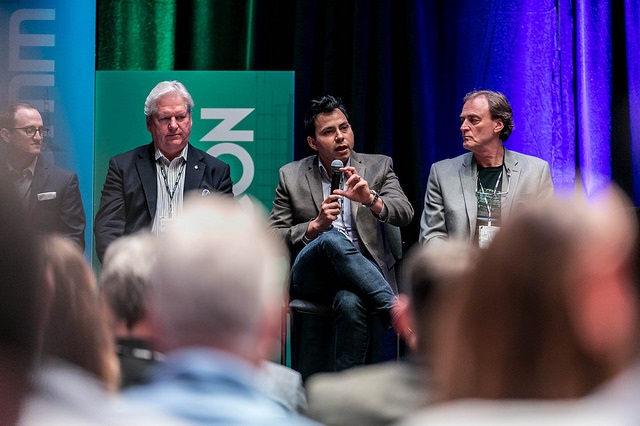The Fear-of-Missing-Out was intense.

Therese Sullivan,
Principal,
|
July 2017 |
[an error occurred while processing this directive] |
| Highlights from Realcomm-IBcon San Diego The Fear-of-Missing-Out was intense. |
 Therese Sullivan, Principal, |
| Articles |
| Interviews |
| Releases |
| New Products |
| Reviews |
| [an error occurred while processing this directive] |
| Editorial |
| Events |
| Sponsors |
| Site Search |
| Newsletters |
| [an error occurred while processing this directive] |
| Archives |
| Past Issues |
| Home |
| Editors |
| eDucation |
| [an error occurred while processing this directive] |
| Training |
| Links |
| Software |
| Subscribe |
| [an error occurred while processing this directive] |
This
year’s Intelligent Buildings conference by Realcomm was again a hotbed
of information exchange and business dealings for all the professions
involved in smart buildings, smart cities, and smart energy projects.
IT/OT convergence, security of networks and data, as well as technology
disruption were big themes, as they have been in past years. My biggest
takeaway from Realcomm/IBcon – San Diego is respect for its host
region. On display at every turn was leadership in interfacing its
corporate and university strengths with community efforts to increase
sustainability and make the most of its water and energy resources.
University of California at San Diego is home to the J. Craig Venter
Institute where ground-breaking research in genomics is taking place.
The project manager and owner's representative during construction of
this world-first net-zero laboratory was on stage at the conference.
Yann Palmore, now with JLL Smart Buildings, was headlining several
sessions, sharing his lessons learned. San Diego has a carbon action
plan (CAP), and net zero thinking is helping it reach its year-by-year
goals. Other net zero project veterans like David Kaneda from the
Integral Group and Ruairi Barnwell of DLR Group were also there
offering insight.
I also heard from Kiva Allgood, formerly President Qualcomm Intelligent
Solutions, Industrial IOT and Smart Cities and now a GE Ventures
Managing Partner. She was a board member of the local trade
association, Cleantech
San Diego
in 2015 when it pulled together the public-private support required to
deploy the IoT for the Port of San Diego. Combining technology and
services from Intel, OSIsoft , Black & Veatch , Dell, and San Diego
Gas & Electric (SDG&E), this project uses sensors to detect
energy consumption and to translate it into easy-to-manage, real-time
data to advance the port's smart city goals. Kiva offered this powerful
illustration during her Smart Cities panel:
Of
course, she was talking about OSIsoft’s signature Pi software, an
industry benchmark for collecting large amounts of data to manage
utility, infrastructure, and building systems. It has a long track
record among municipalities, businesses, and academia. In addition to
the Port of San Diego, the city’s Petco Park is a customer.
Realcomm/IBcon visitors had the opportunity to tour the ballpark during
the conference to take in all the ways Pi is maximizing efficiencies.
Many took in the Padres-vs-Cincinnati game while
they were there. Fun!
David Doll, Industry Principal, Facilities and Energy Management at
OSIsoft participating in a panel discussion about Enterprise IoT,
offered this formula for success:
On the same panel, Steven Meyer, Sr. Principal Engineer - Manufacturing IT at Intel Corporation, offered a perspective that is often missing from such operations-technology-centric gatherings—that of the enterprise IT manager. Meyer said:
So
many conference sessions this year honed in on working through the
differences in the basic charters, educations, and cultures of IT and
OT people. Anto Budiardjo, editor of “A New Deal for Buildings”
blog just posted a new article that captures some of the different
perspectives on this ‘ravine impeding adoption of intelligent
buildings.’ I couldn’t say it better, so I recommend reading Anto’s IT & OT: Convergence or Divergence?
Spoiler alert: he basically agrees with Intel’s Steven Meyers that,
when it comes to IoT deployments, IT has a responsibility to lead and
to offer better service to OT customers.

Building Data Analytics panel with Alex Grace of KGS Buildings, John
Gilbert of Rudin Management, Victor Sanchez of LinkedIn and John Petze
of SkyFoundry.
[an error occurred while processing this directive]Regarding tech disruption, all the rumbling starts with advancements in analytics as well as cloud hosting services. The IBcon expo floor offered the chance to catch up with John Petze, Principal and Co-Founder of SkyFoundry, to ask him about how analytics for buildings are evolving. He explained that the latest release of the SkySpark platform, SkySpark® Everywhere™, is advancing along two vectors: first in terms of distributed edge-to-cloud architectures and then regarding how findings are communicated to human users. He explains:
Every
year it seems like Realcomm-IBcon grows in terms of sessions, tracks,
expo square footage and people to meet; but, the length of time you
have over three day stays the same. The Fear-of-Missing-Out was
intense. It’s a good thing so much is captured by the Realcomm team and
made available in video on the Realcomm Conference Group youtube
channel. This collection of interviews is a great resource for our
industry.
[an error occurred while processing this directive]
[Click Banner To Learn More]
[Home Page] [The Automator] [About] [Subscribe ] [Contact Us]